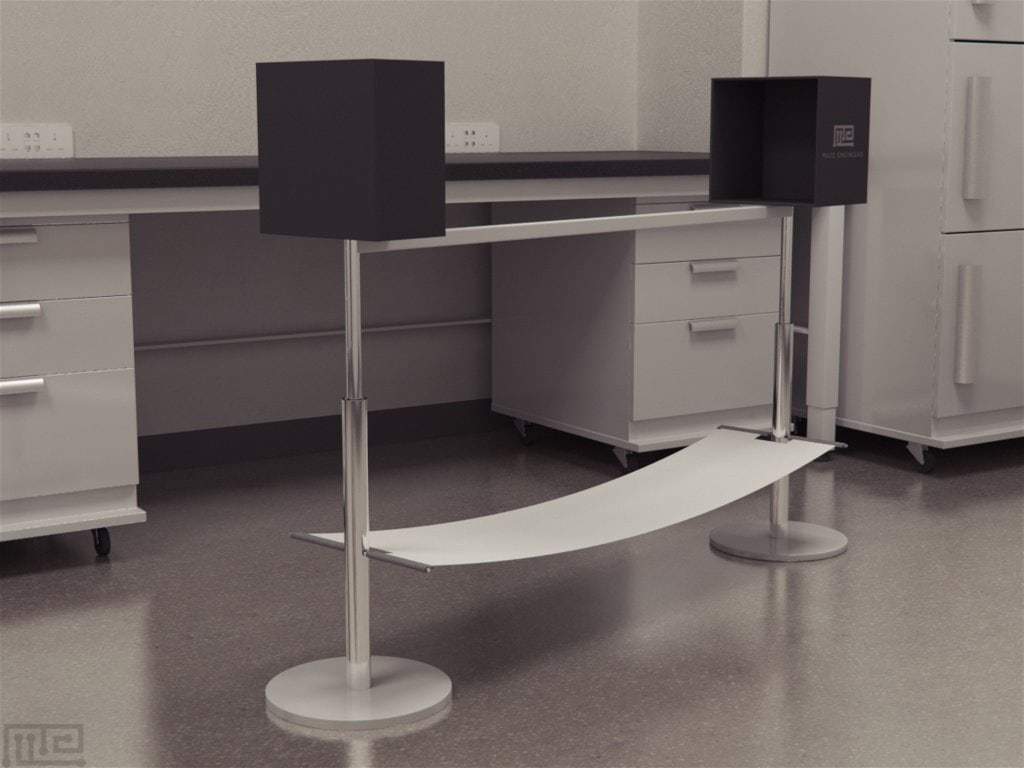

In gymnastics, the balance beam is an elevated apparatus that athletes carefully walk along to demonstrate their balance and coordination. Similarly, the balance beam test is used to assess these abilities in rodents.
The balance beam test is a widely used method in scientific research to evaluate motor coordination and balance. This test involves a narrow elevated beam that the animals must carefully navigate, providing valuable insights into their neuromuscular function and overall motor skills. By observing how rodents perform on the beam, researchers can evaluate how different neurological conditions, treatments, and genetic changes affect their motor skills

Figure: The Balance Beam Apparatus
The balance beam test is quite straightforward. Begin by placing the mouse or rat at the starting end of the beam. Gently encourage the animal to walk across to the other side. Researchers can then measure the time it takes for the rodent to cross the beam, as well as the number of foot slips. A key aspect often evaluated is the performance of the rodents’ hindlimbs. Since these limbs are not typically used for intricate movements, the frequency of foot slips serves as a reliable indicator of hindlimb function [1].
Metz et al. (2000) developed a detailed grading system for the balance beam test. According to their scale, an animal receives a “0” if it cannot stay on the beam at all, a “0.5” if it can make it halfway across before falling, a “1” if it reaches the end, a “1.5” if it partially uses its hindlimbs and makes it across, and a “2” if it travels the length of the beam using normal walking and foot placement patterns [2].
Luong et al. (2011) introduced another grading system, where a rodent earns a “1” if it cannot cross the beam and a “7” if it walks normally across with fewer than two foot slips. If the rodent drags its limbs, it receives a “3”. Additionally, many researchers measure the average time it takes for the rodent to cross the beam, noting how much it stalls or sniffs while on the beam [3]. They also record how long the animal can walk before slipping off the beam, with a safety net in place to catch any falls.
The balance beam test has various applications, including:
Researchers have utilized the balance beam apparatus to investigate the impacts of strokes, Parkinson’s disease [3], Huntington’s disease [4], and traumatic brain injury [5]. These conditions, which impair motor function or cause cortical brain injuries, result in decreased performance on the balance beam test. Specifically, disease or injury models exhibit more foot slips and spend less time on the beam before falling off, indicating a decline in motor coordination and balance.
In the research from 2013, scientists studied mice that were surgically induced with moderate to severe traumatic brain injury. Their findings showed that post-injury, the mice’s ability to stay on the beam and walk across it decreased significantly. Additionally, the injured mice exhibited a notable increase in the number of foot slips, affecting both their forelimbs and hindlimbs [6].
Researchers utilize this test to investigate not only diseases and injuries but also potential treatments. A successful treatment is indicated by a reduction in the number of foot slips and an increase in the duration the mouse remains on the beam.
Figure: Schematic illustration of how treatment affects the Balance Beam Test performance.
Some researchers have begun to favor the balance beam test over the rotarod test due to its increased sensitivity in detecting fine motor deficits [5]. However, if the rodents exhibit significantly decreased motor function due to disease or injury, the balance beam test may be less effective. In such cases, the rotarod test might be more suitable because it offers a wider walking area. Overall, the balance beam remains a simple and straightforward method for assessing balance and motor coordination.
The balance beam test is used in behavioral neuroscience for evaluating motor coordination and balance in rodents. Its simplicity and effectiveness have made it a widely used method in various research fields, including neurological disorders, genetic studies, drug testing, and rehabilitation research. By observing and measuring parameters such as the time taken to traverse the beam and the number of foot slips, researchers can gain valuable insights into the motor abilities of rodents under different conditions.
The test’s sensitivity to fine motor deficits makes it particularly useful for studying subtle changes in motor function that might be missed by other tests, such as the rotarod. This sensitivity is crucial for understanding the progression of diseases like Parkinson’s, Huntington’s, and the effects of traumatic brain injuries. Moreover, the balance beam test is instrumental in evaluating the efficacy of potential treatments, as improvements in performance can indicate the effectiveness of therapeutic interventions.
However, it is important to note that the balance beam test may not be suitable for all scenarios. In cases where rodents exhibit severe motor impairments, the test may not provide reliable data, and alternative methods like the rotarod test, which offers a wider walking area, might be more appropriate. Despite this limitation, the balance beam test remains a valuable and straightforward method for assessing motor coordination and balance.

Vanja works as the Social Media and Academic Program Manager at Conduct Science. With a Bachelor's degree in Molecular Biology and Physiology and a Master's degree in Human Molecular Biology, Vanja is dedicated to sharing scientific knowledge on social media platforms. Additionally, Vanja provides direct support to the editorial board at Conduct Science Academic Publishing House.
